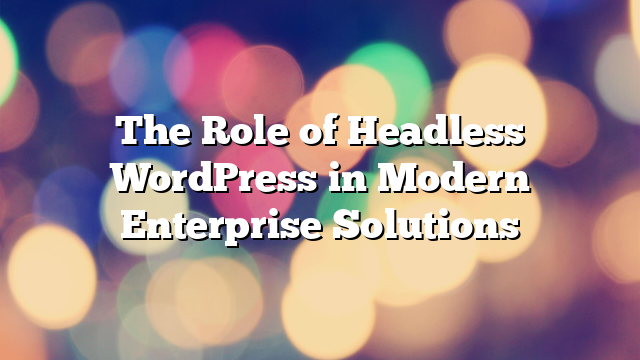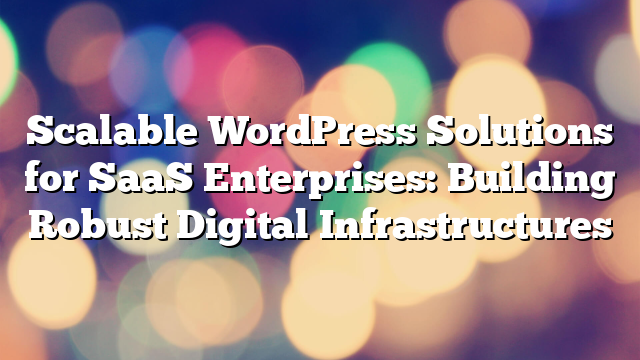The Role of Headless WordPress in Modern Enterprise Solutions
10.12.2024

In today’s digital-first landscape, enterprises are seeking innovative solutions to meet the demands of scalability, flexibility, and performance. Headless WordPress has emerged as a game-changing approach, decoupling the backend content management system from the frontend presentation layer. This enables businesses to leverage modern technologies for dynamic, interactive, and high-performing websites. In this article, we’ll dive into the role of Headless WordPress in modern enterprise solutions and how it’s transforming the digital experience.
What is Headless WordPress?
Headless WordPress separates the backend, where content is created and managed, from the frontend, where content is displayed. Instead of relying on traditional WordPress themes for rendering, Headless WordPress uses APIs (such as REST or GraphQL) to deliver content to various frontends, including websites, mobile apps, and even IoT devices. This decoupled architecture provides greater flexibility and performance for enterprises.
Benefits of Headless WordPress for Enterprises
1. Enhanced Performance
By decoupling the backend and frontend, enterprises can use modern frontend frameworks like React, Vue.js, or Next.js to build fast and responsive interfaces. This significantly reduces page load times and improves user experience.
2. Omnichannel Content Delivery
Headless WordPress allows enterprises to deliver content across multiple platforms, including web, mobile, and third-party devices. This ensures a consistent brand presence and seamless user experience across all touchpoints.
3. Scalability for High Traffic
With the frontend and backend operating independently, enterprises can scale each component separately. This is particularly useful for handling traffic spikes or deploying new features without affecting the entire system.
4. Developer Flexibility
Headless WordPress gives developers the freedom to choose the best frontend technologies for their needs. This allows for highly customized and innovative web applications that aren’t constrained by WordPress’s traditional theming system.
5. Improved Security
Decoupling the frontend from the backend reduces exposure to common WordPress vulnerabilities. Since the backend is not directly exposed to users, it becomes harder for attackers to exploit.
6. Future-Proof Architecture
With a headless setup, enterprises can adapt to emerging technologies more easily. Whether it’s integrating with new APIs or adopting cutting-edge frontend frameworks, Headless WordPress provides the flexibility to evolve with changing trends.
Enterprise Use Cases for Headless WordPress
1. E-Commerce Platforms
Headless WordPress integrates seamlessly with modern e-commerce solutions like Shopify or WooCommerce. Enterprises can use it to create highly interactive shopping experiences that are fast and scalable.
2. Multi-Channel Marketing
Enterprises managing complex marketing campaigns benefit from Headless WordPress by delivering tailored content across websites, mobile apps, and digital signage systems, ensuring cohesive messaging.
3. Content-Heavy Portals
Media companies and enterprises with extensive content libraries can leverage Headless WordPress to deliver fast-loading, interactive platforms without compromising on performance or user experience.
4. Progressive Web Apps (PWAs)
Headless WordPress supports the creation of PWAs, providing app-like experiences directly through the browser. This is ideal for enterprises seeking to engage mobile-first audiences.
Challenges of Adopting Headless WordPress
1. Increased Complexity
Implementing Headless WordPress requires expertise in both backend and frontend technologies. Enterprises may need skilled developers to manage the integration effectively.
2. Higher Development Costs
While Headless WordPress offers numerous benefits, it often requires additional resources and investment during the initial setup compared to traditional WordPress.
3. Limited Plugin Support
Many WordPress plugins are designed for traditional setups and may not work out of the box in a headless architecture. Custom solutions may be needed for specific functionalities.
4. Hosting Considerations
Enterprises need hosting solutions that support headless setups, often requiring separate environments for the frontend and backend. This can add to operational complexity.
Best Practices for Implementing Headless WordPress
1. Define Clear Objectives
Before adopting a headless architecture, identify the specific goals and use cases it will address. This helps ensure alignment with enterprise requirements.
2. Optimize API Performance
Efficient use of APIs is crucial for headless setups. Implement caching and optimize query structures to minimize latency and improve performance.
3. Choose the Right Frontend Framework
Select a frontend framework that aligns with your enterprise’s needs, whether it’s React, Vue.js, or Next.js. Consider scalability, developer familiarity, and project requirements.
4. Secure the Backend
Implement robust security measures for the WordPress backend, including strong authentication, role-based access control, and regular updates to minimize vulnerabilities.
5. Test and Monitor
Thoroughly test the headless setup in a staging environment before deployment. Use monitoring tools to track performance and identify potential issues in real-time.
Conclusion
Headless WordPress offers a powerful solution for enterprises seeking flexibility, scalability, and performance. By decoupling the backend and frontend, businesses can create dynamic, future-proof web applications that cater to diverse user needs. While the transition to headless may involve additional complexity and costs, the long-term benefits make it a worthwhile investment for forward-thinking enterprises.
Ready to embrace the power of Headless WordPress? Contact AllWebDev to learn how we can help your enterprise unlock its full potential with cutting-edge web solutions.



